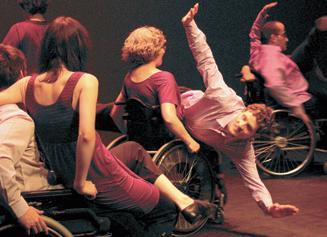Experience the Magic of Movement with Integrated Dance

Propeller Dance was founded in 2007 by Renata Soutter, Shara Weaver andAlan Shain. The company offers classes and workshops for children youth and adults with and without physical, intellectual and psychological disabilities. Propeller Dance also supports a performing group. The company’s focus is on contemporary dance and on creating choreography from movements that the dancers develop, rather than teaching specific dances, like salsa or the tango.

“Our motto at Propeller Dance is, ‘If you can breathe, you can dance,’” says Soutter. The emphasis in the classes is on expression as well as acceptance of one’s own body and others’ bodies. And there is plenty of playful twisting, jumping, wheeling and spinning in pursuit of these goals. “Before I joined Propeller Dance, I had never been shown how to interact with other people with different disabilities,” explains Hoffman. “Now, after three years with the group, I’m really comfortable with all kinds of people. We dance together. We’re good friends.”
Liz Winkelaar began using a wheelchair after a motorcycle accident at age 18 left her paralyzed. She was already working on a master’s degree on disability issues and gender when she joined Propeller Dance. “I wanted to balance that purely academic approach to disability,” she explains. “I still write articles and give talks, but these days I find myself spending a lot of my time dancing and learning more about integrated dance, because I love it so much.”
Being part of the performing group involves weekly rehearsals and frequent high-energy performances at dance festivals, schools, galleries, and corporate and community events. Performing at the Senate Chambers with Propeller Dance in celebration of National Child’s Day last November was a huge honour for Winkelaar and a highlight in her career as a dancer. “I never thought of going into that space, let alone being invited to dance there,” she laughs.
When the Propeller Dance group performs at schools, they include a question-and-answer session with the students to deepen their understanding of integrated dance and increase disability awareness. “If students want to ask questions about my wheelchair, that’s okay,” says Hoffman. “I use my wheelchair every day. It’s a big part of my life.”
Introducing herself at a recent school performance, Winkelaar asked a student without any physical disabilities to show with her body, and not her words, that she felt happy. The little girl jumped up and spun around, with her arms outstretched. Winkelaar responded by spinning her wheelchair with her arm raised, as well. “I like to move my body when I’m happy, too,” she explained.
Winkelaar’s advice for people with disabilities is to stay involved in physical activities and to insist on moving your body. “You have to be more assertive about your right to be included,” says Winkelaar. “I show up at exercise classes all the time. Sometimes the instructor looks surprised to see me, but when I start adapting the movements to what challenges me but is possible, then people soon understand and include me.”
Winkelaar also recommends the Internet as a great resource for people with disabilities who are living in rural areas and might have less access to community programming or to classes in integrated dance or wheelchair sport dance. YouTube videos of dancers with disabilities can be inspirational, for example.
Presently, Propeller Dance’s performing group is working on theatrical skills. They are memorizing choreography and tapping into each dancer’s internal voice and learning to project that to the audience. They are also working on wheelchair tilts. “Our rehearsals involve a lot of power, sweat, emotion and expression,” says Weaver, whose background is equal parts ballet and Ghanaian dance.
The company has a huge local following. Its annual performance was sold out last June, and over 70 people had to be turned away. Collaborating with other integrated dance companies like Montreal’s Corpuscule Danse and participating in events like Vancouver’s KickstART! Festivals are in the plans for the company’s future.
Soutter recently returned from England, where she was studying with Can- DoCo Dance Company, a renowned London-based contemporary mixed physical- ability dance company. Soutter was impressed with the high-level performances but feels strongly that Propeller Dance’s inclusion of dancers with physical and intellectual and psychological disabilities is a more inclusive model for integrated dance.
Propeller’s performing group creates a new dance monthly. Shortly after joining the group, Hoffman realized that she needed to modify her wheelchair so that she could dance more closely with her partners. She moved her wheelchair’s battery from behind her and put it underneath her seat. She also added a platform that other dancers can sit or stand on when they are dancing together.
These modifications have allowed Hoffman to try out all kinds of shared movements. She can do counterbalance spins, and other dancers can hold onto the platform while she turns them. The possibilities are endless, and Hoffman, who has a keen interest in choreography that is being nurtured and supported by Soutter and Weaver, has only just begun to explore them.














